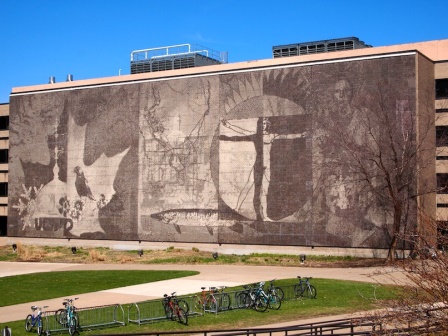
The University of Wisconsin-Stevens Point Mural Project began in 1975 when
Chancellor Lee S. Dreyfus approached Art Professor Richard C. Schneider with the
notion of perpetuating the university’s “Old Main," which was in danger of being
demolished, on the huge empty wall of the newly built College of Natural
Resources. A university committee proposed further ideas which Professor
Schneider incorporated into an overall wall design to represent the university
(as the large human figure in the squared circle near the center right), and the
Stevens Point environs ( in the cupola of “Old Main” at the left
and the map of Portage County vicinity in the center). Wisconsin
is represented by its official Badger and White-tailed Deer at the right, the
Muskie in the center, and Robins, Violets, and a Maple Leaf at the left.
Wisconsin history is symbolized with the representation of a native leader,
Black Hawk, at the upper right. “Old Main” obviously has not been razed, but, as
the historic center of campus, it may nevertheless be seen in its 1976 form as
the unifying background pervading the above figures.
With computer technology donated by Control Data Corporation, the design
was divided into 286,200 tiny squares, each of which was analyzed for light/dark
values on a 28-step scale. Professor Schneider then created designs from the
different Natural Resources disciplines which coincided with the requirements of
the light/dark scale. The computer generated forty photographic negative
printouts which were enlarged and assembled into a 6 by 18 foot composite of the
mural and in which each tiny square appeared as a ¼ inch square of the
appropriate symbol for that value. This assemblage was divided into 646 panels,
mostly 3 by 4 feet, designed to coincide with existing joints on the building
itself.
Because no state tax revenues were authorized for the project, the UWSP
Foundation in 1977 began soliciting gifts of funds and materials, finally
totaling over $100,000, and soon volunteers were able to construct a temporary
studio to house the project. For the next four years, volunteers from the campus
and the community, supervised by student foremen, used silk screens to
hand-print dark brown glaze designs on 2 by 2 inch beige ceramic tile. Created
in numbers and designs required by the computer analysis, the glazed tiles were
fired in kilns to 1350⁰ F. to withstand temperature and humidity
variations. In 1981, workers began laying the tiles in coded sections according
to the large printout. These sections were pasted together and then were
cemented to concrete-fiberglass “Wonderboards” which had already been proven
weatherworthy in over a year of testing. In the summer of 1982, the last of the
panels were completed and were grouted in final preparation for
installation.
One hundred thirteen vertical rows of steel
channels were anchored to the wall with over 7,000 screws to anticipate the
twenty-five tons of tiled panels. The panels were screwed into the steel strips,
after which the nine screws per panel were covered with appropriate tiles which
had been kept out for that purpose. The spaces between panels were caulked for
weatherproofing and the 51 foot high ends were sealed with edge-tiles. The 150
foot long top and bottom edges were protected with metal flashing and screening,
respectively, to complete this impressive work of art.
Because the project was accomplished by many
workers from many ages and walks, and funding came from many sources and in many
forms, and because the grand size and complexity of the mural is composed of
thousands of unique individual tiles, it is appropriate that the finished mural
be entitled, in the words of the our nation’s motto, “E Pluribus Unum,”
“From Many, One.”
